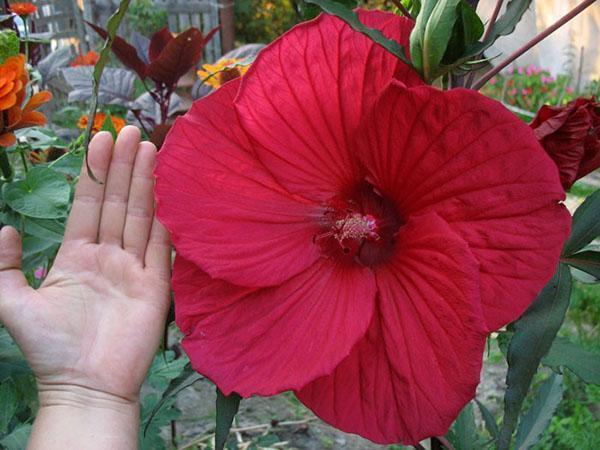Growing herbaceous hibiscus in the garden
 Herbaceous hibiscus is a large-flowered subspecies of a garden flower from the malvaceous family. In addition to the herbaceous varieties of the garden plant, there is another subspecies of this flower - hibiscus tree or Syrian. The cultivation of these hibiscus is different due to their different metabolic processes. Consider the conditions for growing herbaceous hibiscus and its difference from the Syrian subspecies.
Herbaceous hibiscus is a large-flowered subspecies of a garden flower from the malvaceous family. In addition to the herbaceous varieties of the garden plant, there is another subspecies of this flower - hibiscus tree or Syrian. The cultivation of these hibiscus is different due to their different metabolic processes. Consider the conditions for growing herbaceous hibiscus and its difference from the Syrian subspecies.
The growing season of herbaceous hibiscus
Since the shoots of the herbaceous hibiscus are annuals, this flower grows very quickly. Herbaceous hibiscus needs a lot of nutrients to grow vigorously. Unlike the Syrian hibiscus, the herbaceous shrub takes root well in peat soil, but the non-nutritious sandy soil only harms such a plant. During the growing season (from early spring to early autumn), herbaceous hibiscus actively consumes nitrogen from the soil, and for its abundant flowering, it is necessary to apply under the bush:
- magnesium-containing;
- phosphate fertilizers.
Flowering herbaceous hibiscus
A feature of herbaceous varieties of hibiscus is large, one-day flowers. In the twentieth century, two-color varieties with different stains on flowers were bred. Breeders wanted to develop white or yellow varieties of herbaceous hibiscus, but they were not successful. Therefore, in the gardens you can find only plants with red or pink flowers.
Herbaceous varieties begin to bloom in late May - early June. The size of the flowers reaches 30 cm. The next day after flowering, the petals of the herbaceous hibiscus wither and fall off. Only seed pods remain on the peduncle, which can be collected and dried. This way you will get quality planting material for hibiscus propagation.
After the seeds of the first peduncles ripen, the next buds bloom, but, as a rule, it is no longer possible to collect seeds from the second order flowers.
Choosing a landing site and preparing for winter
Herbaceous hibiscus, unlike the Syrian subspecies, does not tolerate even mild autumn frosts, so it is planted in an area well warmed by the sun.
An ideal place for growing herbaceous hibiscus is the southern side of the site, protected from the cold winds in the north. In autumn, before the first frost begins, the aerial part of the flower must be cut off, leaving the stems up to 10 cm high.
In such conditions, the root system of herbaceous hibiscus winters well. During severe frosts, the remaining aerial part of the hibiscus is covered with snow. In the spring, when the snow melts, the herbaceous hibiscus will sprout and then bloom again.